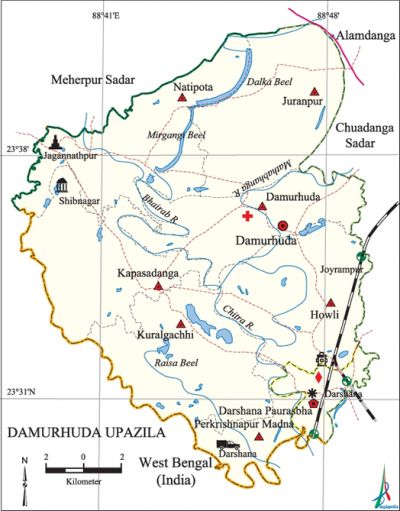Damurhuda Upazila
Damurhuda Upazila (chuadanga district) area 311.91 sq km, located in between 23°29' and 23°42' north latitudes and in between 88°39' and 88°51' east longitudes. It is bounded by alamdanga and meherpur sadar upazilas on the north, west bengal of India on the south, chuadanga sadar upazila on the east, Meherpur Sadar upazila and West Bengal of India on the west.
Population Total 289577; male 145266, female 144311; Muslim 283241, Hindu 4585, Buddhist 4, Christian 1416 and others 331.
Water bodies Main rivers: chitra, bhairab, Mathabhanga; Kanaidanga canal, Hatidanga canal, Kapasadanga canal, Mirgangi Beel, Raisa Beel and Dalka Beel are notable.
Administration Damurhuda Thana was turned into an upazila in 1983.
| Upazila | ||||||||
| Municipality | Union | Mouza | Village | Population | Density (per sq km) | Literacy rate (%) | ||
| Urban | Rural | Urban | Rural | |||||
| 1 | 7 | 74 | 107 | 60768 | 228809 | 928 | 51.96 (2001) | 41.3 |
| Municipality | ||||||||
| Area (sq km) |
Ward | Mahalla | Population | Density (per sq km) |
Literacy rate (%) | |||
| - | 9 | 25 | 33396 | - | 59.0 | |||
| Upazila Town | ||||||||
|
Area |
Mouza |
Population |
Density |
Literacy rate | ||||
| 17.03 (2001) | 5 | 27372 | 982 (2001) | 49.4 | ||||
| Union | ||||
| Name of union and GO code | Area (acre) | Population | Literacy rate (%) | |
| Male | Female | |||
| Damurhuda 11 | 9271 | 20928 | 20514 | 45.8 |
| Perkrishnapur Madna 23 | 7625 | 12510 | 12544 | 45.3 |
| Howli 35 | 14375 | 20005 | 20007 | 44.9 |
| Juranpur 47 | 11897 | 18451 | 18224 | 42.3 |
| Kapasadanga 59 | 10805 | 23219 | 23079 | 43.5 |
| Kuralgachhi 71 | 7983 | 14910 | 14733 | 36.6 |
| Natipota 83 | 11302 | 18561 | 18496 | 35.8 |
Source Bangladesh Population Census 2001 and 2011, Bangladesh Bureau of Statistics.
Archaeological heritage and relics Mazar of Malek-ul Gaus (Charulia), Mazar of Reza Shah Chisti (Kosaghata), Mazar of Kutub-ul Alam Shah (Munshipur), mazar and mosque of an unidentified Pir (Shibnagar), Jagannathpur Mandir.

Historical events The indigo resistance movement and the peasant movement extensively spread over Damurhuda upazila. The peasants of this region played an important role in the no-rent movement in 1869 and 1873. The first peasant conference in Bengal was held in April 1920 in this upazila.
War of Liberation During the war of liberation in 1971 the Pak army burnt down a lot of houses at village Madna of the upazila and killed many innocent people. Eight freedom fighters were martyred in an encounter with the Pak army at Baguan on 5 August 1971. There had an encounter once again at the same place on 24 August and on 25 November, there had been a fight of the joint troop of freedom fighters and allied forces against Pak army at Par Kunjapur. A Memorial monument has been built in memory of the myrtars on the Darshana-Mujibnagar regional highway.
For details: see দামুড়হুদা উপজেলা, বাংলাদেশ মুক্তিযুদ্ধ জ্ঞানকোষ (Encyclopedia of Bangladesh War of Liberation), বাংলাদেশ এশিয়াটিক সোসাইটি, ঢাকা ২০২০, খণ্ড ৪।
Religious institutions Mosque 228, temple 4, church 4, Eidgah 30.
Literacy rate and educational institutions Average literacy 44.2%; male 44.7%, female 43.6%. Educational institutions: college 3, secondary school 25, primary school 109, kindergarten 4, madrasa 24. Noted educational institutions: Natudaha High School (1906), Damurhuda Pilot High School (1913), Memnagar B.D Secondary School (1916), Kuralgachhi Secondary School (1923), Kalabari-Ramnagar Secondary School (1926), Darshana Secondary Girls' School, Madna Secondary School, Bishnupur Secondary School, Kapasadanga Secondary School.'
Cultural organisations Library 3, club 70, social welfare centre 3, cinema hall 2.
Main sources of income Agriculture 64.53%, non-agricultural labourer 3.08%, industry 0.53%, commerce 14.11%, transport and communication 2.34%, service 6.56%, construction 0.10%, religious service 0.13%, rent and remittance 0.36% and others 5.85%.
Ownership of agricultural land Landowner 59.81%, landless 40.19%; agricultural landowner: urban 48.02% and rural 63.15%.
Main crops Sugarcane, paddy, wheat, pulse, potato, barley, corn, jute, gram, betel leaf, onion.
Extinct or nearly extinct crops Sesame, linseed, mustard, tobacco, indigo.
Main fruits Mango, jackfruit, pineapple, papaya, banana.
Fisheries, dairies and poultries Dairy 34, poultry 424, breeding centre 3.'
Communication facilities Roads: pucca 207 km, semi-pucca 53 km, mud road 416 km; waterway 1 km; railway 14 km.
Extinct or nearly extinct traditional transport Palanquin, horse carriage.
Noted manufactories Rice mill, sugar mill, flour mill, saw mill, ice factory.
Cottage industries Blacksmith, weaving, potteries, brass and bell-metal work, embroidery, wood work, cane work.
Hats, bazars and fairs Hats and bazars are 20, fair 1, most noted of which are Damurhuda Hat and Dugdugir Hat.
Main exports Betel leaf, banana, mango, sugar, onion, muk pulse.
Access to electricity All the wards and unions of the upazila are under rural electrification net-work. However 60.4% dwellings have access to electricity.
Sources of drinking water Tube-well 95.7%, tap 1.4% and others 2.9%. The presence of arsenic has been detected in the shallow tube-well water of the upazila.
Sanitation 50.2% of dwelling households of the upazila use sanitary latrines and 42.8% of dwelling households use non-sanitary latrines; 7.0% of households do not have latrine facilities.
Health centres Upazila health complex 1, family planning centre 8.
NGO activities brac, asa, CARE, WAVE Foundation. [Iman Siddiqi]
References Bangladesh Population Census 2001 and 2011, Bangladesh Bureau of Statistics; Cultural survey report of Damurhuda Upazila 2007.
